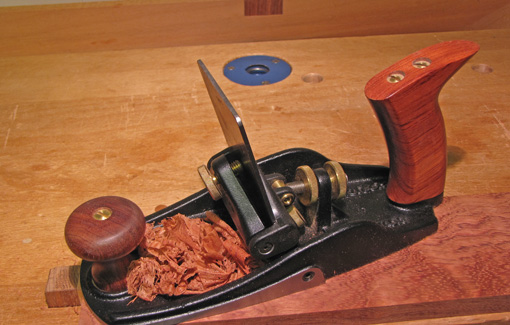Here are my preferences in a scraping plane, followed by the styles that are thus disqualified in parentheses:
- a sole long enough relative to its width to register on the work and not “fall off” at the end of a stroke (not: Stanley #80 and other spokeshave-like styles)
- an adjustable frog angle (not: #’s 80, 85, Veritas small scraping plane)
- a mechanism to camber (bow) the blade (not: #’s 80, 85, 12, 112, 212, Veritas small)
- a mechanism to easily and precisely fine tune the depth of cut (not: #’s 80, 85, Veritas small)
I know of only one manufactured tool that meets all these criteria: the Veritas large scraping plane. All of this is a matter of personal preference, and there are many other high quality scraping planes available, most notably from Lie-Nielsen, that you may like better. I will explain why I like the Veritas, a patented, unique tool.
The deal-sealer for me is that the blade can be bowed. This is done by simply applying pressure with a thumbscrew which meets the lower back of the blade. This does more than just avoid the corners of the blade from digging in. That effect, after all, could be accomplished on a non-bowed blade just by cambering the cutting edge (and/or rounding the corners) in the sharpening process, just as one might do with a plane blade. More important, this bowing pre-tensions the cutting edge, just as you do with your fingers when using a card scraper. This greatly helps reduce blade chatter.
The frog angle adjustment mechanism can be set just right considering the angle at which you burnished the blade, the wood, the desired aggressiveness of the cut, and the state of wear of the blade’s hook. I sharpen the blade bevel at about the standard 45̊, and take the final burnishing passes at about 15̊ off horizontal. I set the frog at the same angle that the blade lightly bites into the wood when held by hand. This is usually somewhere around 10-12̊ forward of vertical for a fresh hook.
Just as important, this mechanism acts as a very precise depth of cut adjuster. Because the pivot point of the frog is slightly behind (closer to the tote than) the point where the blade meets the wood, slightly tilting the frog further forward from vertical will deepen the blade projection (depth of cut).
The procedure to do this precisely is somewhat counterintuitive. To tilt the frog less (shallower cut), spin the front nut away from the thread housing to create clearance, put light forward pressure against the frog, and “tighten” the rear nut against the housing. Retighten the front nut. To tilt the frog more (deeper cut), spin the rear nut away from the housing, put light rearward pressure against the frog, and turn the front nut against the housing. Retighten the rear nut. This method allows you to see and feel the frog moving slowly and precisely.
Next, I will discuss blade options.



Thanks for the series. I bought this scaper a while back, but my initial usage did not produce what I wanted, and I put it back into the box. My thinking was that I would get it back out when I needed it again. But I actually, knew that I needed guidance and practice.
I appreciate you sharing your working experience with this product.
You’re welcome, John. Thanks for reading.
I’m glad the scraper is working out for you now. The most sensitive things to get right are the blade tilt and projection as discussed in the last three paragraphs above.
Rob
I plan to read a lot more. I met Al Navas in November and got to your blog via his. I LOVE figured wood, and I can see that you do too. I have already drooled over some of the woods that you have posted.
Of course, like the rose and its thorns, figured wood comes with its tear out and I want to master working with it.
John,
Good luck and enjoy your work with figured woods!
I find it is helpful to have several different modes to manage figured woods, including the Veritas scraping plane, bevel down and bevel up planes with a few different blade preparations and a toothed blade, card scrapers, and, yes, sandpaper.
Each species, figure, and board has its own personality and quirks. It’s worth the trouble.
Rob